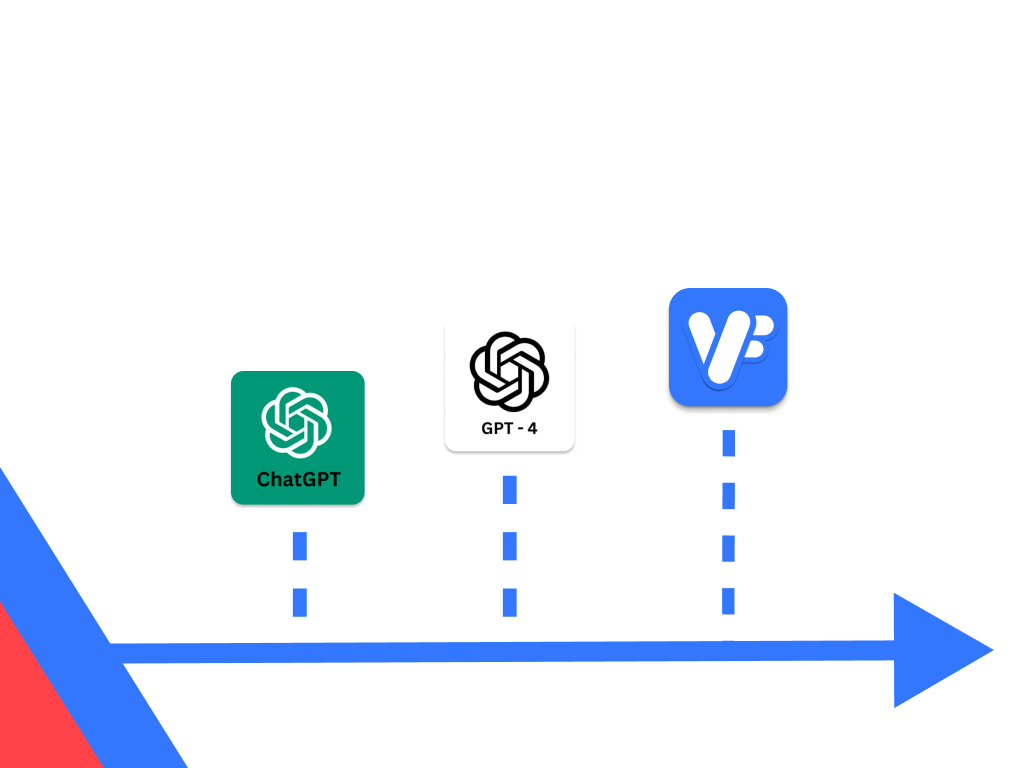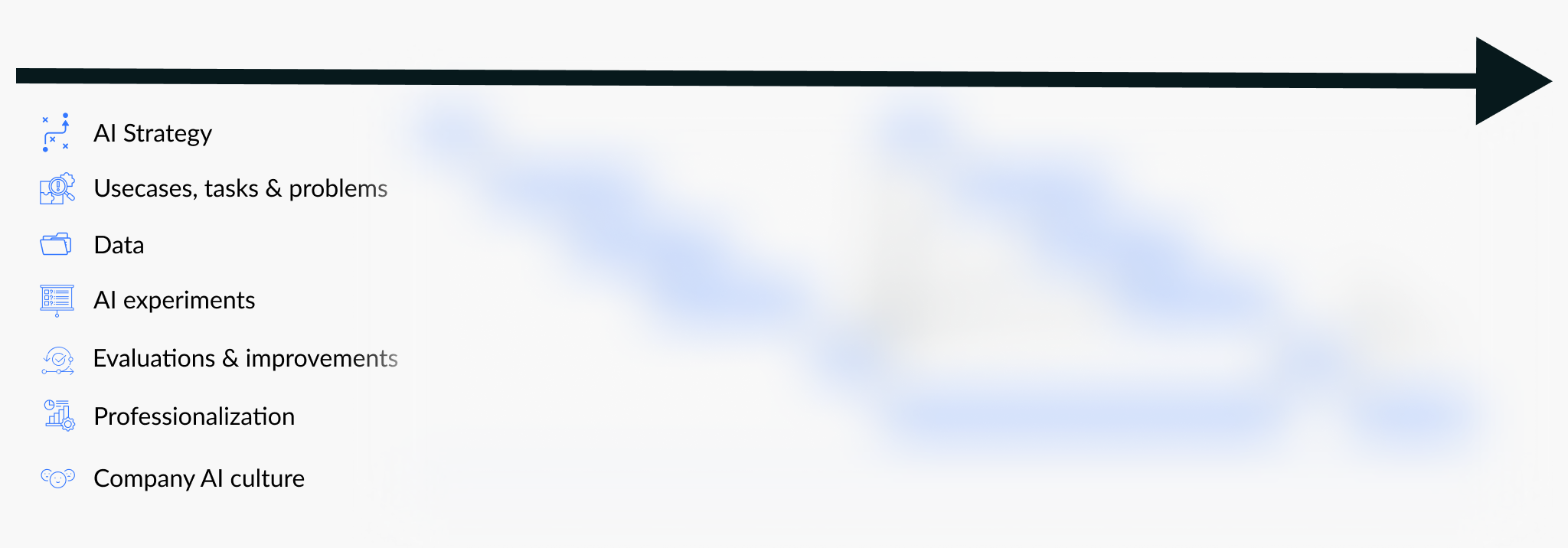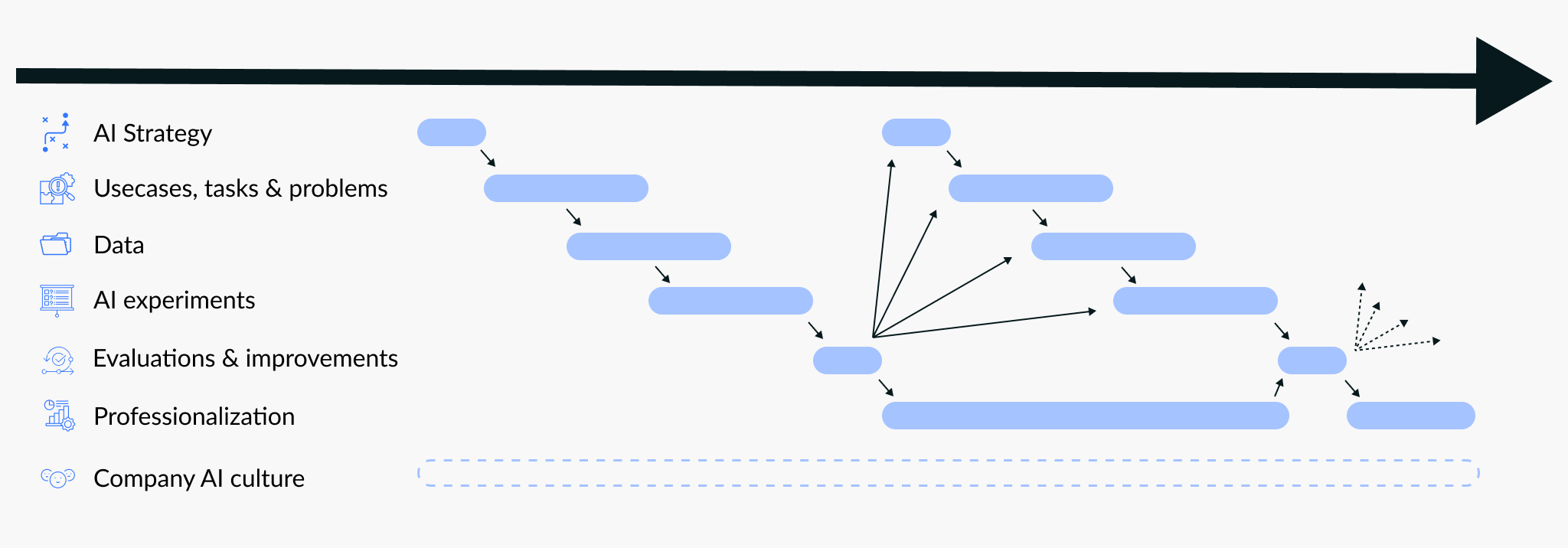
AI journeys for smaller companies
How small and medium-sized companies
can pursue a successful AI journey.
04/2024
In this article, we’ll explore what an AI journey looks like for small and medium-sized companies, including the various stages they encounter and key focus areas at each step.
The concept of an AI journey is similar to the broader digital transformation journey that many companies undergo to digitize their business processes. Specifically, it’s akin to an AI-focused version of the data maturity model. During an AI journey, companies typically aim for two direct goals: firstly, to achieve greater productivity for internal processes by enhancing process automation, which helps in reducing costs. Secondly, to develop externally facing products and services that can boost revenue through offerings that were previously not feasible. These two goals contribute to the overall objectives of staying competitive, gaining a competitive advantage, and optimizing long-term success.
This article shall help to bring you closer these goals. Now, let’s dive into each stage of an AI journey, examining the specific milestones and strategies involved, before discussing the overall journey and its iterative nature.
1. Decide on an AI strategy
Introducing new technology should ideally be done in a structured manner, with a well-thought-out strategy and S.M.A.R.T. goals (for a general take on what makes a strategy great, we can recommend this article).
For smaller companies, which often operate with limited budgets—both in terms of personnel and finances—developing a clear strategy and precise positioning regarding AI is particularly important. Crafting a sound AI strategy involves several key aspects including decisions on its strategic value, customization needs to your specific industry or company specifics, cost management, maintaining trustworthiness, securing data collection or possibly hiring decisions. A comprehensive discussion on formulating a robust AI strategy is beyond the scope of this article, but those interested in diving deeper can consider booking one of our AI strategy workshops. Once a company has defined its (at least preliminary) AI strategy, it is ready to move on to the next stage of its AI journey.
2. Identify use cases, tasks and problems
In this stage of your AI journey, it’s important to thoroughly examine the typical tasks, processes, or problems that occur in your daily operations. Identify which of these are repetitive, carry significant importance, and are often urgent. Arrange these in a rough order of priority without yet considering how AI might resolve them or even if AI should be used at all.
At this point, think as if you would handle these issues manually. You are still in the “problem space,” where your focus is solely on identifying and understanding the problems independently of potential solutions. This step ensures that when you do start to apply AI, you are addressing the most critical and impactful areas of your business.
3. Work with your data
Now, start exploring data that you consider relevant to the problems and tasks you’ve identified. Ask yourself which data you would ideally like to have, what data is crucial, and where it can be sourced from both within and outside your company. Consider which data you typically use when handling tasks manually and what informal knowledge you utilize—this could be never-recorded insights that employees have about certain processes or clients. Recognizing these types of data and sources is vital as they will increase the quality of later AI outputs significantly.
The next step is to collect this identified data. This might involve gathering internal documents, tapping into public websites, databases, APIs, or even formalizing tacit knowledge that hasn’t been documented yet within your company. Once you’ve gathered your data sources, it’s important to ensure they are of high quality. The saying “garbage in, garbage out” is especially true in data analytics and AI. High-quality data without errors or excessive noise is essential for the success of any AI initiative.
For smaller companies beginning their AI experiments, it isn’t necessary to spend months on data collection. Starting with a single, relevant document or website, or collecting data over just a few days can be sufficient. The small amount of data is only used to quickly test and refine their AI experiments without a massive upfront investment in time and resources.
4. Run AI experiments
After identifying tasks you would like to augment with AI and collecting the necessary data, it’s time to begin with initial experiments. These experiments are crucial as they allow employees to get a firsthand experience of working with AI. They can see the potential benefits and learn about what currently works well and what remains challenging.
During this exploratory phase, focus on “low-hanging fruits” or quick wins — those use cases that can be easily addressed with AI to deliver immediate results. This approach not only builds confidence in the technology but also provides valuable learning experiences. It’s also important to experiment not just with the use cases themselves but also with various tools that could be used within your company on a daily basis. Explore different tools and approaches, noting which features meet your needs and which are unnecessary.
For instance, test popular tools like chat-based applications such as ChatGPT (team), API-based AI models like GPT-4 or Google’s Gemini API, as well as AI assistants and workflow tools like ValueFlow. By experimenting with these tools, you can better understand which solutions fit your specific requirements and help streamline your processes most effectively.
5. Evaluate & improve
As you conduct your experiments with AI tools and solutions, it’s essential to systematically evaluate the outputs you receive. Rate which outputs you like best and take the time to articulate why you prefer one solution over another. Formalize your evaluations briefly; this information will be invaluable later when optimizing solutions.
While reviewing these outputs, provide feedback that includes not only your preferences for specific results but also meta aspects such as the desired tone, words you would avoid, and communication styles you want to emphasize. Structure and formalize these insights to shape the way AI integrates into your operations. This evaluation process helps you learn which tasks AI can solve effectively and which solutions are still lacking. It also identifies which data sources are beneficial and determines the tools you need and want to use AI effectively in your smaller company.
After this stage, you will be able to decide which experiments to professionalize and which to neglect or deprioritize.
6. Professionalize AI usage
Once you’ve learned from your initial experiments, you can make informed decisions about which projects to expand, optimize, and professionalize. This involves dedicating more time to refining the prompts, improving data sources, and enhancing the overall workflow. Providing additional background knowledge and conducting more thorough testing are also key steps at this stage.
Additionally, consider automating solutions for repetitive tasks to increase efficiency. At this point in your AI journey, it’s also advisable to select a primary AI tool. Having experimented with multiple options, you should now have a good sense of which tool best meets your needs and can deliver the most value.
By professionalizing the most promising solutions to this stage, you are positioning your company very well to benefit significantly.
7. Embrace a positive AI culture
Growing a positive and beneficial AI culture within a company is often invisible process, primarily because culture evolves organically rather than being directly controlled.
Although leadership, employees, and strategies can influence cultural development, they do so indirectly. Each stage your company has undergone in its AI journey has already shaped this evolving culture, and every interaction with AI going forward will continue to influence it. One effective way to cultivate a healthy AI culture is to methodically follow the AI journey, step by step, and focus on continuous improvement.
By taking deliberate actions at each stage and reflecting on the learnings and outcomes, your company not only becomes more proficient with AI technologies but also integrates these advancements into the organizational ethos in a way that is positive and sustainable. This approach ensures that AI becomes a natural part of your company’s identity, fostering an environment where innovation thrives.
8. The complete AI journey
If we visualize these stages using a Gantt chart, we see that the AI journey involves iterative cycles through each stage. You typically progress through each stage step-by-step, although okay to start some stages while still completing others.
Note the first “intersection”: After completing the AI experiments and evaluating what you’ve learned, you reach a decision point where you determine which experiments to professionalize and which to discontinue. You also take these learnings into the next iterative cycle, using the new insights to reassess your AI strategy, redefine use cases, reevaluate the data you’re collecting, and decide on new experiments to initiate.
In this visualization, you can see the AI culture dimension represented separately from the other stages. This depiction underscores the pervasive nature of cultural influences across all stages, highlighting that while culture is omnipresent, it cannot be directly controlled or manipulated. It evolves indirectly as a result of interactions and experiences throughout the AI journey.
Conclusion
In this article, we presented an AI journey tailored to smaller companies, breaking down the potentially overwhelming task of implementing AI solutions into smaller, manageable steps. This approach helps rather non-technical companies pursue AI integration step-by-step, demonstrating that successfully implementing AI solutions does not require extensive technical knowledge.
By simplifying the process and highlighting the minimal technical requirements needed at many stages, we hope to empower more businesses to explore the potential of AI and recognize that it is well within their reach to harness its benefits effectively.
April 2024 | ValueFlow team
Reach out with comments or suggestions:
comment@valueflow.ai


